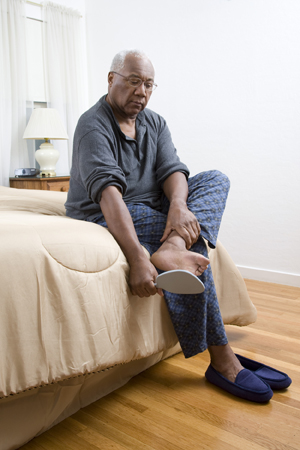Treating Peripheral Neuropathy
Treating Peripheral Neuropathy
Peripheral neuropathy is a disease of the nerves. It most often starts in your feet and may also eventually affect the arms. It may cause pain or may make you unable to sense pain. Sometimes, weakness occurs as well. Lack of pain and weakness makes you more likely to injure yourself without knowing it.
Learn ways to protect your feet. Check your feet daily for wounds you may not have felt. Avoid burns by testing bath water with your elbow before stepping in. Also, always wear shoes to prevent injury.
Regular foot care
If you have foot numbness, you may not notice cutting yourself while trimming your nails. To prevent problems, your healthcare provider may ask you to visit for nail and callus trimming. See your provider for foot care as often as suggested.
Check your feet daily
Catch problems early by checking your feet every day for changes. Look at the top and bottom of your feet, your heels, and between your toes. It may help to use a mirror. If this is hard, ask someone to check for you. Call your healthcare provider if you notice a wound, ulceration, ingrown nail, or any changes in your feet. This includes increased heat, swelling, numbness, tingling, pain, and redness.
Wear proper footwear
Always wear shoes and socks, even indoors. Ask your healthcare provider how to choose the right shoe. After buying shoes, bring them to your doctor to be checked for proper fit. Take new shoes off every hour or so to check for red pressure areas on your feet. Each time you put on your shoes, use your fingers first to feel inside for foreign objects.
Common causes of peripheral neuropathy
Some common causes of peripheral neuropathy include:
Diabetes or other endocrine disorders
Toxins (such as alcohol)
Nutritional deficiencies (such as Vitamin B-12)
Kidney disease
Injury
Repetitive stress (such as carpal tunnel syndrome)
Autoimmune disease
Cancer and tumors
Chemotherapy
Arthritis
Advanced age
Heredity
Infection
Diagnosis and treatment
Diagnosis of peripheral neuropathy includes a complete history and physical exam. Lab tests including blood work and imaging often help determine the cause. Special nerve tests are often helpful including nerve conduction velocity studies (NCV), and electromyography (EMG).
Treatment focuses on treating the underlying disorder and treating symptoms through the use of medicines, injections, TENS (transcutaneous electrical nerve stimulation), acupuncture, massage, and other methods.
Updated:
January 03, 2018
Sources:
England, JD, Distal Symmetric Polyneuropathy: A Definition for Clinical Research, Neurology (2005); 64; pp. 199-207
Reviewed By:
Sather, Rita, RN,Shelat, Amit, MD
